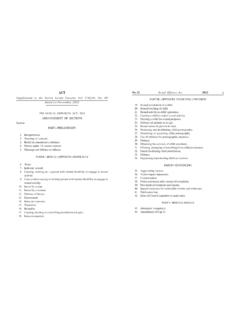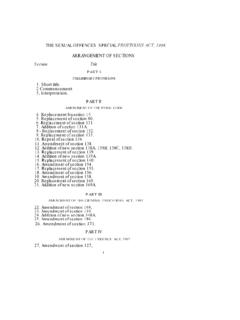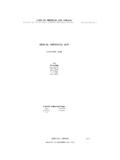Transcription of GUIDELINES FOR MEDICO-LEGAL CARE FOR VICTIMS OF …
1 GUIDELINES FOR MEDICO-LEGAL care FOR VICTIMS OF sexual VIOLENCE948 Documentation and reportingSUMMARY All consultations with patients must be documented in the form of hand-written notes, diagramsor body charts and, if appropriate, photography. Use of standard examination forms can greatlyassist the process of documentation, and ensure that important details are not omitted. All aspects of the consultation should be documented, including consents given; medicalhistory; account of the abuse; outcome of the physical examination; samples taken; tests andtheir results; treatments and medications prescribed; and schedule of follow-up care and referrals. In the interests of accuracy, notes should be made during the course of the consultation,rather than after. Patient records are strictly confidential and should be stored securely. Health workers may be required to comment on their findings in a written report and/or giveevidence in court.
2 If so required, health workers must ensure that their evidence is impartial andrepresents a balanced interpretation of their findings. If not trained in MEDICO-LEGAL matters, health workers should confine their service to healthcare provision and documentation of findings, and leave the interpretation of physical and otherobservations to a suitably qualified DocumentationHealth workers have a professional obligation to record the details of anyconsultation with a patient. The notes should reflect what was said (by thepatient, in her own words) and what was seen and done (by the health worker).In cases of alleged sexual abuse, the taking of accurate and complete notesduring the course of an examination is critical for the following reasons: As medical records can be used in court as evidence, documenting theconsequences of sexual violence may help the court with its decision-makingas well as provide information about past and present sexual violence.
3 Documenting that a patient has been a victim of sexual violence will alertother health care providers who later attend the patient to this fact and soassist them in providing appropriate and sympathetic follow-up care . Documentation can provide administrators and policy-makers with anestimate of the incidence and prevalence of sexual violence that can be usedto guide decisions about allocating resources (see also section Epidemi-ological surveys). How and what should be documented?Mechanisms for documenting consultations include hand-written notes,diagrams, body charts and photography. Photography should be used tosupplement, not replace, the other methods of recording findings and isdiscussed in more detail below (see section Photography).Some states or local authorities provide standard forms or proformas forrecording the details of medical consultations.
4 A sample proforma has beenprepared by WHO specifically for recording consultations with VICTIMS of sexualviolence and is attached to these GUIDELINES as Annex 1. This proforma can becopied and used as it stands, or can be adapted to suit local needs sexual abuse cases, documentation should include the following: demographic information ( name, age, sex); consents obtained; history ( general medical and gynaecological history); an account of the assault; results of the physical examination; tests and their results; treatment plan; medications given or prescribed; patient education; referrals and accurate documentation can be assured by following theset of instructions given in Box 9. In the interests of patient safety, healthworkers are advised not to make a note of the names, addresses or telephonenumbers of any shelter or safe houses given to the patient.
5 It is usually sufficientto make an entry in the records to the effect that, Patient was given referralsfor emergency shelter and counselling .8. DOCUMENTATION AND REPORTINGBOX 9 Documenting cases of sexual abuse: a check-list for health workersThe following check-list is intended to assist health workers develop their documentation skills: Document all pertinent information accurately and legibly. Notes and diagrams should be created during the consultation; this is likely to be far more accuratethan if created from memory. Notes should not be altered unless this is clearly identified as a lateraddition or alteration. Deletionsshould be scored through once and signed, and not erased completely. Ensure that the notes are accurate; deficiencies may cast doubts over the quality of the assessment. Record verbatim any statements made by the victim regarding the assault.
6 This is preferable towriting down your own interpretation of the statements made. Record the extent of the physical examination conducted and all normal or relevant FOR MEDICO-LEGAL care FOR VICTIMS OF sexual Storage and access to recordsPatient records and information are strictly confidential. All health careproviders have a professional, legal and ethical duty to maintain and respectpatient confidentiality and autonomy. Records and information should not bedisclosed to anyone except those directly involved in the case or as required bylocal, state and national statutes (20).All patient records (and any specimens) should be stored in a safe evidence usually needs to be refrigerated or frozen; check with yourlaboratory regarding the specific storage requirements for biological Epidemiological surveysMedical records of cases of sexual violence are a rich source of data forsurveillance purposes.
7 Information can be used to determine (12): the patterns of sexual violence; who is most at risk for becoming a victim of sexual violence; locations or areas where there is a high incidence of sexual violence; the time of day when most of the offences take place; medical and staffing resources required to improve the care of, and servicesto, VICTIMS of sexual information will give an indication of how serious the problem of sexualviolence is, pinpoint where prevention measures are most urgently needed andwill allow service providers to monitor the effectiveness of health servicesavailable to VICTIMS of sexual violence. This information, however, must beinterpreted with caution as it is known that sexual abuse is greatly under-reported. Women seeking help from health services may represent only the tipof the information required to serve the above-mentioned functions isretrievable from the sample WHO sexual Violence Examination Record (seeAnnex 1).
8 It is critical that data used for surveillance purposes should have allpatient identifiers removed; this ensures patient PhotographyIf using photography to document findings, the following points are worthbearing in mind: Consider the subjects will be uncomfortable, unhappy, tired orembarrassed. Communicate the role of photography and obtain informedconsent for the procedure. photograph must identify the subject, the date and thetime that the photograph was taken. The photographs should be boundwith a note stating how many photographs make up the set. Ideally, a newroll of film should be used for each subject; alternatively, there should be aclear indication of where a new series commences. photograph of the colour chartshould commence the sequenceof photographs. Scalesare vital to demonstrate the size of the injury. They97may be placed in the horizontal or vertical plane.
9 Photographs should betaken with and without a scale. first photograph should be a facial shot for identificationpurposes; this may not be required if the photographs have been adequatelyidentified (see above). Subsequent shots should include an overall shot ofthe region of interest followed by close-up shots of the specific injury orinjuries. Chain of should be logged as for other forensic evidence (seesection 5 Forensic specimens). form part of a patient record and as such should beaccorded the same degree of confidentiality. Legitimate requests forphotographs include those from investigators and the court. If, however, acopy is made for teaching purposes, the consent of the subject or his/herparents/guardian should be obtained. taking of photographs (of any region of the body) is consideredto be inappropriate behaviour in some cultures and specific consent forphotography (and the release of photographs) may be required.
10 Consent tophotography can only be obtained once the patient has been fully informedabout how, and why, the photographs will be taken. The briefing should alsoexplain how this material may be used ( released to police or courts andcited as evidence). Providing written evidence and court attendanceIt is beyond the scope of this document to deal with the specific obligations ofhealth care practitioners in meeting the needs of the justice system. Generallyspeaking, however, the health worker would be expected to (92): be readily available; be familiar with the basic principles and practice of the legal system andobligations of those within the system, especially their own and those ofthe police, as it applies to their jurisdiction; make sound clinical observations (these will form the basis of reasonableassessment and measured expert opinion); reliably collect samples from VICTIMS of crime (the proper analysis offorensic samples will provide results which may be used as evidence in aninvestigation and prosecution).
















